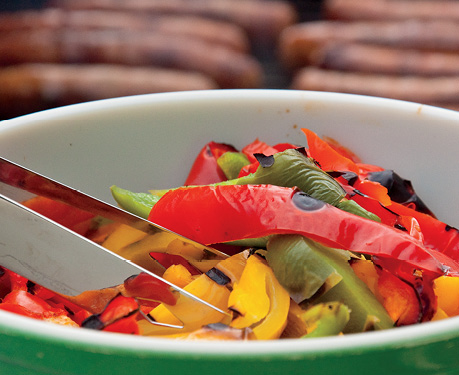A Better Italian Sausage Sandwich
In Italy there are hundreds of regional salsiccia. In the U.S., the term Italian sausage has a specific flavor profile. It is a thick tube of coarsely ground pork sausage in natural pork casings, with a distinctive flavor from fennel seed. It is sold raw by butchers, and it can be bought in links, in coiled ropes, or loose like burger meat. It usually comes in three flavors: sweet, mild, and hot. The main difference is the amount of hot pepper added, although some sweet blends include basil, and the heat and other seasonings vary significantly from butcher to butcher. If you can’t find a butcher selling good sausage near you, try the Italian sausage recipe on AmazingRibs.com.
A versatile ingredient, Italian sausage commonly shows up on pizza, in red sauce for pasta, in bean soups, and in bread-based stuffings. But its greatest glory is in a bun. The classic Italian sausage sandwich is grilled and topped with griddle-fried onions and sweet peppers, and often anointed with giardiniera, a spicy-hot blend of chopped hot peppers, carrots, cauliflower, celery, olives, herbs, salt, and black pepper, all packed in oil and/or vinegar. Some places offer sausage sandwiches with a marinara sauce and melted mozzarella. The trick is to grill the sausages over medium heat so the casings don’t split.

Makes 4 sandwiches
Takes about 50 minutes
- 4 (6-inch-long) slices Italian bread, from a long skinny loaf, or 4 oblong Italian bread rolls, split (see Notes)
- 4 tablespoons olive oil (see Notes)
- 2 green bell peppers, halved lengthwise and cut into ¼-inch-wide strips
- 2 red bell peppers, halved lengthwise and cut into ¼-inch-wide strips
- 2 large onions, halved through the root and sliced into half-moons
- 4 fresh Italian sausage links
1. Prep. Let the sausages sit at room temperature for about 15 minutes so the skins warm a bit. This helps keep them from splitting, spilling their guts, and dumping oil on the fire.
2. Fire up. Set up the grill for two-zone cooking and shoot for about 325°F on the indirect side.
3. Cook. Toast the bread over direct heat, if you like.
4. Put an 8- to 12-inch oven-proof frying pan on the heat. Pour in the olive oil and swirl the pan to coat the bottom in the oil. Add the peppers and onions and stir to coat with oil. Stir the peppers and onions and cook until wilted and slightly browned, but not burned. A scorch mark or two is OK. Take them off when they are done and let them sit at room temperature. You can cook the peppers and onions a day in advance, even indoors if you wish, and just warm them before serving.
5. If the sausages are curved, bend them gently to straighten them slightly. Lay them on the direct-heat side between the gaps of the grate. Cook with the lid open so you can watch them to prevent burning. Do not poke them to drain the fat! This dries them out and causes flare-ups and soot. They must cook until they are 160°F in the center to be safe. Usually they are properly cooked after two or three of the sides have browned. Don’t burn them and don’t overcook them and dry them out.
6. Nestle the sausage in the bread and top liberally with peppers and onions, making sure plenty of flavorful oil gets into the bread, and serve.


Notes: Italian bread is a spongy, high-gluten loaf with a medium-hard crust.
The amount of olive oil listed is about twice as much as you may think you need, but it’s the way it’s done. You can grill the peppers and onions on a grill topper (see page 103) if you wish, although it is not exactly traditional and you don’t get the richness of the olive oil.